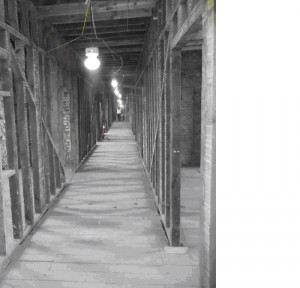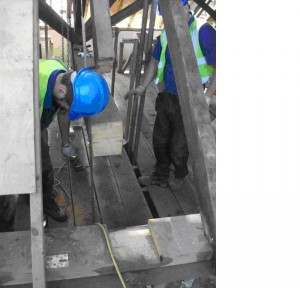I’m Jon Butler and I work as a Quantity Surveyor and Project Manager on Project SLAM, an ongoing programme of work to provide improved Single Living Accommodation for non-married military personnel. Sometimes this is done by designing and building whole new blocks of bedrooms and sometimes we renovate existing blocks.
Recently I was watching a programme on the construction of Crossrail across London and the difficulties one of the teams had faced in modifying an existing Victorian rail tunnel running underneath the Thames to allow the passage of modern trains. This highlighted the key issue I have faced as a project manager over the last few years when undertaking the full refurbishment of a number of Grade 2 listed buildings for DIO, and that is to expect the unexpected.

My first project as project manager was the refurbishment of the Grade 2* listed Senior Non-Commission Officer (SNCO) mess at Woolwich Barracks, the frontage of which may be familiar to many as it is used in numerous DIO articles and publications and is the longest protected façade in Europe.
This was closely followed by the refurbishment of the Hardinge block at Cavalry Barracks in Hounslow, London. It was on the "at risk" register and was occupied only by a flock of pigeons which had taken residence. I now have two refurbishment projects running concurrently at Woolwich and Cavalry Barracks.
All of these projects have provided numerous examples of the unexpected and have provided challenges for the contractor and DIO team to overcome.
Cavalry Barracks
The Cavalry Barracks has a long history with the military, starting with the Barons who assembled there to celebrate the signing of the Magna Carta. Centuries later, its strategic position close to London made it an ideal place for Cromwell to gather his forces before marching on the capital in the Civil War.
Permanent buildings were erected in the latter part of the 18th Century with the Officer’s Mess at the head of the parade square built circa 1793. It was extended and re-fronted in 1876 and had numerous ad hoc buildings added to the rear over the years. Nowadays it's the home of the Welsh Guards.


The alterations to the building have left their mark on the Officers’ Mess in one way or another - some good and some bad. Unfortunately, the only way these become apparent is by removing the fabric of the building.
We’re currently undertaking specialist historic work to refurbish and provide 49 Junior Officer and eight Senior Officer en suite bedrooms, together with new kitchen facilities and a refurbished mess area. The building is Grade 2 listed which presents its own challenges!

Structural Problems
While it is to be expected that a building of this age will have suffered some degradation over the years, it is not until the full skeleton of the building is exposed by removing all the ceilings, plaster from the walls and lifting the floor boards on the ground floor that one can appreciate the true repair works required.
The team has been faced with rotten timbers (e.g. wet and dry rot) which have involved close liaison with the structural engineer to come up with innovative construction techniques to solve the problem. We also found examples of unsatisfactory repair work previously undertaken which do not meet current standards.

Any repair work carried out has to be structurally sound and also has to meet the guidelines of English Heritage. For example, roof repairs involve removing as little as possible of the rotten element, often inserting resin into the timber or structural steel plates to provide additional support.
Expect the Unexpected
The unexpected generally involves problems and extra cost. For example, in one situation we discovered that floor boards had been lifted in one room so that demolished material from previous alteration works could be dumped into the basement. This left not only a potential fire hazard but also a damp festering mess. However there was a silver lining - a rumour that the building contained an inaccessible basement full of water has (thankfully) not materialised!
So while there are many unexpected details to overcome sometimes these are all part of the "fun" of undertaking a refurbishment project!